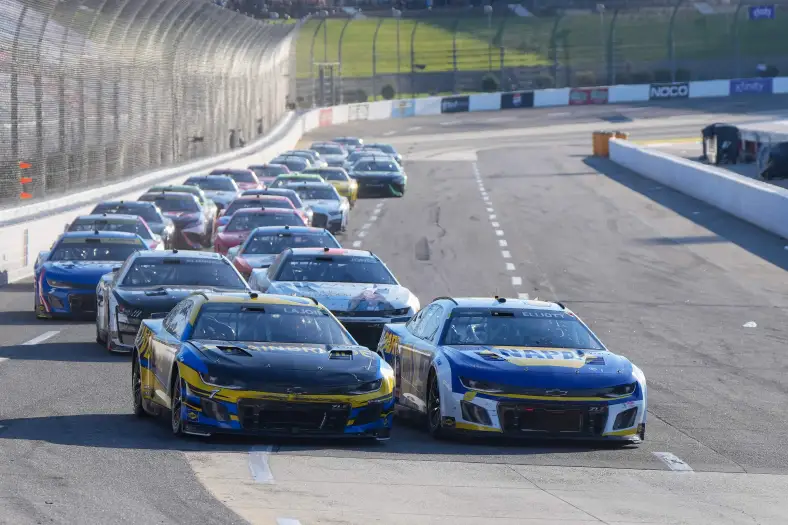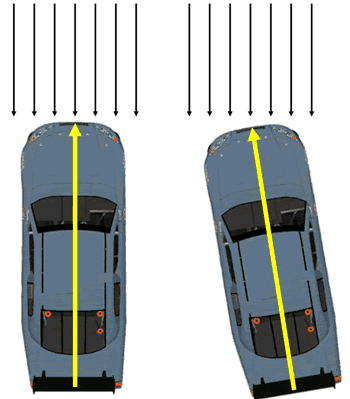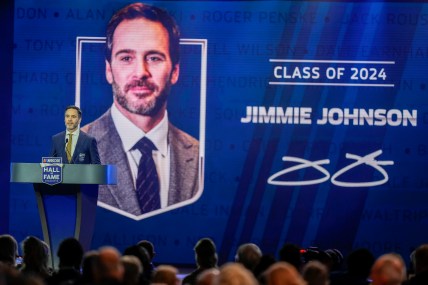
As detailed earlier in the month, NASCAR has taken yet another swing towards improving short track and road course races during the third year of competition for the NextGen car.
The challenges have the past two seasons have been well documented. While the car has objectively provided better quality of races on intermediate length tracks, it has come at the expenses of tracks that feature flatter surfaces and heavier braking zones.
It basically comes down to the car having not enough horsepower for its weight, a completely sealed underbody, wider tires and a larger brake package. NASCAR has responded to that challenge by taking a tremendous amount of downforce off the car in the form of rear spoiler and front splitter adjustments but it largely hasn’t moved the figurative needle.
Thus, the latest swing announced on January 10.
• 2023 short track/road course splitter stuffers
• No engine panel strakes
• 3-inch spoiler
• Simplified Diffuser
• Simplified Diffuser Strakes

During a preseason research and development briefing for the media on Tuesday in Concord, North Carolina, NASCAR Vice President, Vehicle Design Brandon Thomas articulated why they landed on their latest package and where balance was struck in making various efforts.
Keep in mind that NASCAR has conducted numerous tests over the past two years in trying to solve this particular puzzle. The latest changes were the result of a test at Phoenix in early December but there was also a test over the summer at Richmond, which focused on a splitter that was designed to move up and down based on whether a car was in clean air or traffic.
That’s one of the root problems, that the car suffers a tremendous loss of downforce in dirty air, which makes passing a challenge even for a car that is faster at face value.
So, first came NASCAR testing what it called the up/down splitter, something that went through extensive computer testing before it was attempted at Richmond. That coincided with NASCAR even taking more overall downforce off the car.
“We’ve tried, at various stages of the tests, to take downforce off the car,” Thomas said. “One of the things that was front and center was a new splitter. This splitter was aimed at traffic management, and the management of aerodynamics in traffic.
“We thought that the splitter could be optimized to run in a specific traffic situation. As we worked on all that, the reality of what was tried at say Richmond in the middle of last summer and what we took to Phoenix, we took another step of downforce off.
“We have taken downforce off, taken downforce off, taken downforce off and taken downforce off to make these guys have to drive the car. We finally got to a spot where, with really good drivers in the car, they told us this was probably too much downforce off the car.”
While taking downforce off the car, at face value, makes them inherently harder to drive and can create slipping off the corner to initiate passing, it also minimizes tire wear and it becomes even harder to pass if the cars can’t be driven side-by-side in turbulence. This car also has virtually no sideforce to catch the car once it starts to go around.
There is a balance to be struck and NASCAR believes it went too far in downforce reduction.
“Drives told us they felt like they didn’t have enough control to attack the car in front of them or stay beside it,” Thomas said. “So, we had to decide, what does this mean. With the shorter (rear diffuser), the interesting thing to come out of it was the car’s behavior in yaw.”

NASCAR believes it is getting closer to the way previous generations of cars felt when in the corner, like in the graphic above, providing drivers a little more slip, which wears the tires and creates opportunities to pass.
Thomas believes this package will be directionally positive.
“We had a couple of drivers, right off the bat with the shorter diffuser say it felt better as they slipped the car, the back end of the car, a little bit,” Thomas said. “The spoiler change was to get the (overall) downforce levels back to the same neighborhood … We’re trying to operate at a similar zip code downforce level that we have been but I expect to see a lot of commentary from drivers about the back end of the car, and that feel, being able to slip the car around.”
This is all combined with a tire that Goodyear brought to Phoenix that was more aggressive in nature and one drivers praised more than the aerodynamic changes. Most drivers want a horsepower increase but that remains seemingly off the table for now.
